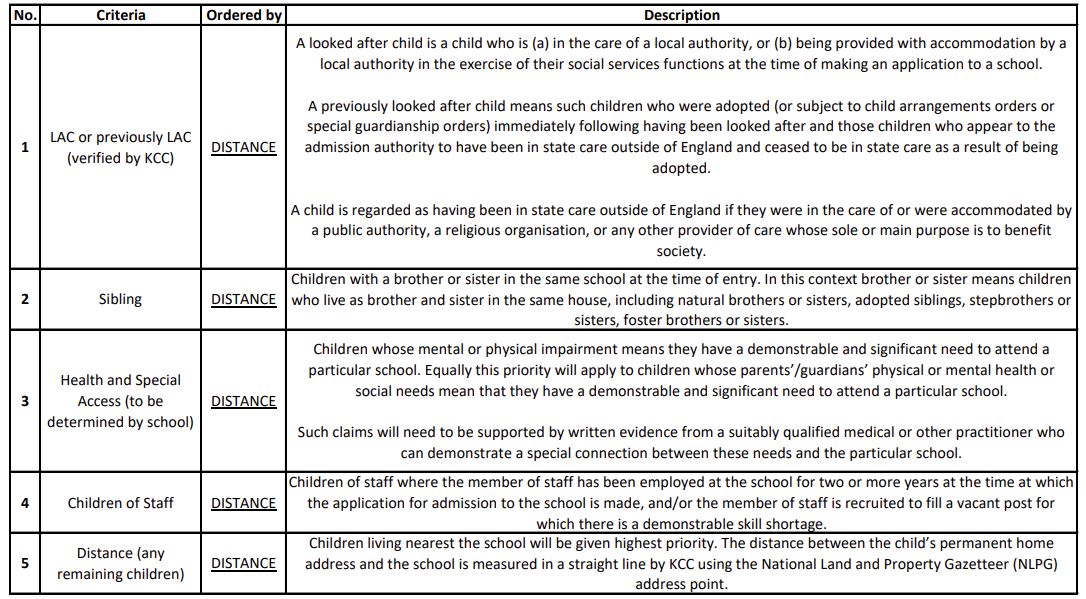Admissions
We welcome families to visit our school and find out more about our philosophy and what we do.
For Primary In Year Casual Admissions the procedure has changed. If you live in another Local Authority’s area but want a Kent school place you should apply through your own Local Authority. If you live in Kent or are about to move to Kent you must complete an In Year Casual Admissions Form and send it to:
office@mundella.kent.sch.uk or
Mundella Primary School, Black Bull Rd, Folkestone, Kent, CT19 5QX
where your request will be processed.
Full information on this procedure can be obtained from the “Guidance for Completing In Year Casual Admission Form” notes available from Kent County Council or the school office. You will need to fill in a separate form for each child.
IYAF - In Year Casual Admissions Form
Mundella Admissions Policy 2024/25
Mundella Admissions Policy 2025/26
Oversubscription Criteria
All children whose education, health and care (EHC) plans name the school will be admitted before any other places are allocated.
If the school is not oversubscribed, all applicants will be offered a place.
In the event that the school receives more applications than the number of places it has available, places will be given to those children who meet any of the criteria set out below, in order until all places are filled.
Highest priority will be given to looked after children and all previously looked after children who apply for a place at the school.
1. Children in Local Authority Care – a child under the age of 18 years for whom the Local Authority provides accommodation by agreement with their parents/carers (Section 22 of the Children Act 1989) or who is the subject of a care order under Part IV of the Act. This applies equally to children who immediately after being looked after by the local authority became subject to an adoption, residence or special guardianship order (as defined by Section 46 of the Adoption and Children Act 2002 or Section 8 or 14A of the Children Act 1989.)
2. A brother or sister attending the school when the child starts. In this context, ‘brother or sister’, means a child who lives as a brother or sister in the same house, including natural brothers and sisters, adopted siblings, stepbrothers and sisters and foster brothers and sisters.
3. Health and Special Access Reasons – medical, health, social and special access reasons will be applied in accordance with the school’s legal obligations, in particular those under the Equality Act 2010. Priority will be given to those children whose mental or physical impairment means they have a demonstrable and significant need to attend the school. Equally this priority will apply to children whose parents’/guardians’ physical or mental health or social needs mean that they have a demonstrable and significant need to attend this particular school. Such claims will need to be supported by written evidence from a suitably qualified medical or other practitioner who can demonstrate a special connection between these needs and the school.
4. Nearness of children's homes to school - The school uses the measurements provided by the Local Authority who use the distance between the child’s permanent home address and the school, measured in a straight line using Ordnance Survey address point data. Distances are calculated from a point defined as within the child’s home to a point defined as within the school as specified by Ordnance Survey. The same address point on the school site is used for everybody. A child’s home is considered to be a residential property that is the child’s only or main residence (not an address at which the child may sometimes stay or sleep) and which is either owned by the child’s parent, parents or guardian or leased or rented to them under a lease or written rental agreement. Where partners live apart but share responsibility for the child, and the child lives at two different addresses during the week, we will regard the home address as the one at which the child sleeps for the majority of week days.
6.4 Tie break
In a tie breaker situation the proximity of an applicant’s home to the school will be the decider. If in the event that more than one applicant lives the same distance from home to the academy (as measured by the local authority), then a random selection will be applied and independently supervised.
Applications for entrance into any school within Veritas Multi Academy Trust should be made through Kent Primary Admissions Scheme. You will be required to complete the Reception Common Application Form (RCAF) either online through the KCC website or by completing a paper form available from October 2020 at Kent primary schools or the Local Authority Admissions Office. The application process will open in early November 2020.
Late applications will be placed on a waiting list and places allocated based on the above criteria.
After a place has been offered, the school reserves the right to withdraw the place in the following circumstances:
-
When a parent has failed to respond to an offer within a reasonable time.
-
When a parent has failed to notify the school of important changes to the application information.
-
The admission authority offered the place on the basis of a fraudulent or intentionally misleading application from a parent.
If you have not been offered a place you can request to be placed on the school’s waiting list. The school’s waiting list will be re-ranked, in line with the published oversubscription criteria, every time a child is added.
Requests for Admission Outside the Normal Age Group
Parents are entitled to request a place for their child outside of their normal age group. If you would like to request a place for your child outside their normal age group, please book an appointment with the headteacher to discuss your request.
Decisions on requests for admission outside the normal age group will be made on the basis of the circumstances of each case and in the best interests of the child concerned. In accordance with the School Admissions Code, this will include taking account of:
- Parents’ views
- Information about the child’s academic, social and emotional development
- Where relevant, their medical history and the views of a medical professional
- Whether they have previously been educated out of their normal age group
- Whether they may naturally have fallen into a lower age group if it were not for being born prematurely
- The headteacher’s views
Wherever possible, requests for admission outside a child’s normal age group will be processed as part of the main admissions round. They will be considered on the basis of the admission arrangements laid out in this policy, including the oversubscription criteria listed in section 6. Applications will not be treated as a lower priority if parents have made a request for a child to be admitted outside the normal age group.
Parents will always be informed of the reasons for any decision on the year group a child should be admitted to. Parents do not have a right to appeal if they are offered a place at the school but it is not in their preferred age group.
If you need any further information please do not hesitate to contact.



